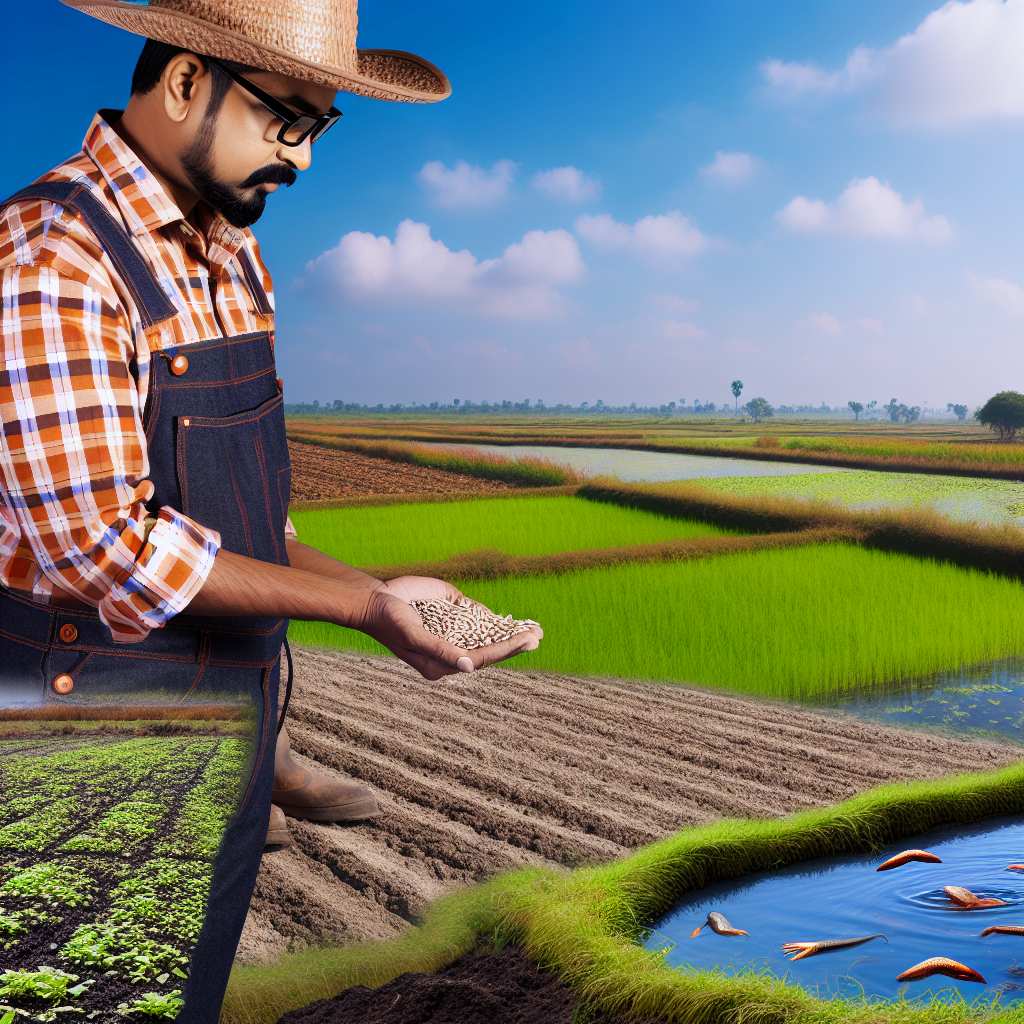Introduction to Permaculture and Its Relevance to Biodiversity
Permaculture represents a holistic approach to agriculture and land design.
It integrates sustainable practices that mimic natural ecosystems.
This system fosters biodiversity and enhances resilience on farmlands.
Many farms today face challenges like soil degradation and habitat loss.
Permaculture offers solutions by creating thriving ecosystems.
The Core Principles of Permaculture
Permaculture is built on several core principles.
These principles guide farmers in designing productive landscapes.
- Observe and interact with nature.
- Catch and store energy effectively.
- Apply self-regulation and accept feedback.
- Use and value renewable resources.
Benefits of Biodiversity in Farming
Enhancing biodiversity provides numerous benefits for farming.
It improves soil health by promoting microbial diversity.
Biodiverse farms are more resilient to pests and diseases.
Furthermore, they can adapt better to climate fluctuations.
Connecting Permaculture and Biodiversity
There is a strong connection between permaculture practices and biodiversity.
Implementing permaculture encourages diverse plant and animal life.
This practice creates habitats that attract beneficial insects.
In turn, these insects pollinate crops and control pests naturally.
Transform Your Agribusiness
Unlock your farm's potential with expert advice tailored to your needs. Get actionable steps that drive real results.
Get StartedExamples of Permaculture Practices to Enhance Biodiversity
Several specific practices can greatly enhance biodiversity.
- Intercropping different species to create diverse ecosystems.
- Planting cover crops to protect and enrich the soil.
- Establishing wildlife corridors to support animal movement.
- Utilizing agroforestry techniques to integrate trees and crops.
By applying these practices, farmers can significantly increase biodiversity.
Ultimately, these strategies lead to more productive and sustainable farms.
Understanding the Key Principles of Permaculture
Designing with Nature
Permaculture emphasizes working with natural ecosystems.
It encourages farmers to observe and mimic natural patterns.
This approach promotes a more sustainable agricultural system.
Moreover, it fosters harmony between the land and its inhabitants.
Emphasizing Diversity
Diversity plays a critical role in permaculture practices.
It includes a variety of species that interact beneficially.
This enhances resilience against pests and diseases.
Additionally, biodiversity improves soil health and ecosystem stability.
Utilizing Layers in Design
Permaculture uses a layered approach to farming.
This method incorporates different plant heights and structures.
Each layer plays a distinct role in the ecosystem.
For instance, taller plants provide shade and shelter.
Conversely, ground cover plants minimize soil erosion.
Emphasis on Sustainability
Permaculture prioritizes sustainable resource management.
Farmers focus on renewable resources wherever possible.
This includes using rainwater collection and composting.
Sustainable practices enhance soil fertility and crop yields.
Creating Closed Loops
The concept of closed-loop systems is vital in permaculture.
This means that waste from one system becomes input for another.
For example, animal manure can enrich soil for crops.
Such practices reduce reliance on external resources.
Showcase Your Farming Business
Publish your professional farming services profile on our blog for a one-time fee of $200 and reach a dedicated audience of farmers and agribusiness owners.
Publish Your ProfileCommunity and Collaboration
Permaculture promotes a sense of community among farmers.
Collaborative efforts enhance knowledge sharing and resource access.
This strengthens local food networks and economies.
Additionally, communities can tackle environmental challenges together.
The Role of Soil Health in Promoting Biodiversity
Importance of Soil Diversity
Soyl health directly influences biodiversity on farms.
Diverse soil microorganisms support plant growth and resilience.
Healthy soils create a habitat for various organisms.
These organisms contribute to nutrient cycling and pest control.
Soil Structure and Composition
Good soil structure enhances water infiltration and root growth.
Well-aerated soil fosters the activity of beneficial organisms.
Additionally, organic matter improves soil fertility and biodiversity.
Farmers should focus on maintaining optimal soil pH levels.
Organic Matter and Its Benefits
Incorporating organic matter is essential for soil health.
Compost and cover crops enhance soil’s biological activity.
They provide food for soil organisms, promoting biodiversity.
Furthermore, organic matter retains moisture, reducing irrigation needs.
Practices Enhancing Soil Health
Implementing crop rotation diversifies soil nutrients.
This practice reduces pest and disease pressures as well.
Using minimal tillage protects soil structure and organisms.
Moreover, mulching with organic materials enriches the soil.
Monitoring Soil Health
Regular soil testing helps assess health and fertility parameters.
Farmers should look for indicators like microbial activity.
Also, they must track changes in soil organic matter over time.
These assessments guide effective management practices.
Find Out More: Maximizing Farm Resources By Transforming Surplus Produce Into Value-Adds
Techniques for Implementing Polyculture Systems on Farmlands
Understanding Polyculture
Polyculture involves growing multiple crops in the same space.
This technique promotes biodiversity and increases resilience against pests.
For example, you can pair legumes with grains for nutrient exchange.
Moreover, using diverse plants supports a variety of beneficial insects.
Choosing Compatible Species
Select plants that complement each other well.
Beans, corn, and squash create a classic trio known as the Three Sisters.
Each plant supports the others, enhancing overall yield.
Additionally, consider planting herbs that repel pests alongside vegetables.
Layering Techniques
Utilize vertical space by layering plants at different heights.
For instance, you can plant tall sunflowers with low-growing ground cover.
This arrangement maximizes sunlight and space efficiency.
Furthermore, crops like cucumbers can benefit from climbing structures.
Rotational Planting
Implement rotational planting to foster soil health.
This practice prevents soil depletion and disrupts pest cycles.
Rotate crops seasonally to maintain nutrient levels in the soil.
Showcase Your Farming Business
Publish your professional farming services profile on our blog for a one-time fee of $200 and reach a dedicated audience of farmers and agribusiness owners.
Publish Your ProfileAs a result, your farmland becomes more sustainable over time.
Incorporating Livestock
Integrate livestock into your polyculture systems for added biodiversity.
Chickens can help control insects while providing natural fertilizer.
Additionally, livestock grazing can improve pasture health.
Thus, integrating animals contributes to a balanced ecosystem.
Implementing Companion Planting
Companion planting enhances crop productivity through strategic pairings.
For example, pairing tomatoes with basil improves flavor and growth.
Furthermore, certain flowers can attract pollinators and repel pests.
This method encourages healthier plants and higher yields.
Utilizing Ground Cover Crops
Plant ground cover crops to prevent soil erosion and suppress weeds.
Clover and vetch are excellent options for enriching soil nitrogen.
These plants also provide habitat for beneficial organisms.
Consequently, ground covers enhance overall farm biodiversity.
Monitoring and Adapting Practices
Regularly monitor your polyculture systems for health and productivity.
Adjust practices based on observed results and local conditions.
Seeking feedback from other farmers can provide useful insights.
Ultimately, adaptability leads to greater success in polyculture farming.
Gain More Insights: Organic Dairy Farming Practices for Sustainable Milk Production
The Benefits of Incorporating Native Plants in Permaculture Designs
Native plants significantly enhance biodiversity on farmlands.
They provide habitat for numerous species and promote ecological balance.
Additionally, they attract beneficial insects, such as pollinators.
Incorporating these plants supports local wildlife populations.
Enhancing Biodiversity
Native plants are well adapted to local soil conditions.
They improve soil structure and promote nutrient cycling.
These plants also reduce erosion through their deep root systems.
Healthy soils contribute to sustainable agricultural practices.
Improving Soil Health
Using native plants lowers maintenance requirements significantly.
They generally need less watering and fertilization.
Additionally, native plants are resistant to local pests and diseases.
This resilience reduces the need for chemical inputs.
Reducing Maintenance Needs
Native plants are more tolerant to local climate variations.
They can withstand periods of drought or heavy rainfall.
This resilience is crucial in adapting to climate change impacts.
Farms that embrace native plants are future-ready.
Climate Adaptation
Incorporating native plants honors traditional agricultural practices.
These practices often reflect the cultural significance of local flora.
Farmers can reconnect with their heritage through native planting.
This approach fosters a sense of community and identity.
Supporting Cultural Heritage
See Related Content: Permaculture Practices for Efficient Water Conservation Methods
Creating Habitats for Beneficial Insects and Wildlife
The Importance of Habitats
Habitat creation is crucial for attracting beneficial insects and wildlife.
Showcase Your Farming Business
Publish your professional farming services profile on our blog for a one-time fee of $200 and reach a dedicated audience of farmers and agribusiness owners.
Publish Your ProfileThese creatures play essential roles in pollination and pest control.
Furthermore, diverse habitats contribute to ecosystem resilience.
Types of Habitats
Farmers can establish various habitats on farmland.
Flowering plants provide food and shelter for pollinators.
Additionally, native shrubs and trees can create safe nesting areas.
Water sources like ponds also attract diverse wildlife.
Planting Techniques
Use intercropping to enhance habitat complexity.
Mix different plant species in your fields.
This practice encourages beneficial insects to thrive.
Moreover, incorporate cover crops to improve soil health.
Containing Natural Predators
Encourage natural predators by planting hedgerows.
These are effective barriers that shield crops from pests.
Predator habitats increase biodiversity in agricultural systems.
Maintaining Habitats
Ongoing maintenance ensures habitats remain productive.
Regularly remove invasive species that threaten local biodiversity.
Add mulches to retain moisture and suppress weeds effectively.
Monitor habitat changes annually to assess their health.
Community Involvement
Engaging the community promotes broader biodiversity efforts.
Host workshops to educate on habitat creation strategies.
Encourage local schools to participate in planting days.
Collaboration enhances habitat networks across landscapes.
Explore Further: Community-Supported Agriculture: Nurturing Biodiversity On American Farms

Water Management Practices that Enhance Biodiversity
Creating Water Retention Features
Water retention features improve the water cycle on farmlands.
These include swales, ponds, and rain gardens.
By capturing runoff, they support aquatic life.
Additionally, they provide water sources for wildlife.
Implementing Rainwater Harvesting
Rainwater harvesting collects precipitation for agricultural use.
This reduces reliance on external water sources.
Farmers can use cisterns or barrels for storage.
Moreover, it contributes to soil moisture levels.
Utilizing Permaculture Design Principles
Permaculture designs incorporate water-efficient systems.
For example, zoned systems help manage water use effectively.
Rotating crops can enhance soil structure and water retention.
Thus, increasing biodiversity within the ecosystem.
Incorporating Riparian Buffers
Riparian buffers protect waterways from agricultural runoff.
They enhance water quality while providing habitat for species.
Native plants in these zones support pollinators and birds.
Moreover, they stabilize soil along riverbanks and streams.
Practicing Controlled Irrigation
Controlled irrigation methods optimize water usage on farms.
Drip irrigation directs water precisely to plants’ roots.
Showcase Your Farming Business
Publish your professional farming services profile on our blog for a one-time fee of $200 and reach a dedicated audience of farmers and agribusiness owners.
Publish Your ProfileThis minimizes evaporation and runoff.
Consequently, it enhances plant health and biodiversity.
Adopting Cover Cropping
Cover cropping improves soil structure and moisture retention.
These crops prevent erosion and support beneficial organisms.
Leguminous cover crops can fix nitrogen in the soil.
This further enhances plant diversity in crop rotations.
Case Studies of Successful Permaculture Farms Boosting Biodiversity
Rainbow Farm
Rainbow Farm in Oregon showcases an innovative approach to biodiversity.
They integrate diverse crops alongside native plants.
This synergy attracts various pollinators and beneficial insects.
As a result, the farm observes increased yields and healthier ecosystems.
Green Meadows Farm
Green Meadows Farm employs companion planting to enhance biodiversity.
They grow herbs and flowers among vegetable crops.
This practice helps deter pests naturally without chemicals.
Consequently, the farm enjoys robust harvests and thriving wildlife habitats.
Sky View Acres
Sky View Acres adopts agroforestry techniques to boost biodiversity.
They plant fruit trees among crops for shade and habitat.
This method improves soil health and creates microclimates.
Farmers report better growth rates and improved air quality.
Harmony Gardens
They implement permaculture zones to cultivate various species.
This structuring encourages symbiotic relationships among plants.
Consequently, they notice an uptick in soil fertility and resilience.
Sunny Hill Farm
Sunny Hill Farm practices holistic grazing techniques to increase biodiversity.
The rotational grazing system promotes diverse pasture growth.
This approach supports the health of livestock and soil alike.
As a result, the farm sees enhanced ecosystem function and productivity.
Wildflower Acres
Wildflower Acres specializes in native plant restoration along their fields.
This initiative boosts local pollinator populations significantly.
Moreover, it increases resilience against pests and disease.
Farmers enjoy healthier crops and valuable ecosystem services.
Challenges and Solutions in Applying Permaculture for Biodiversity Gains
Understanding the Common Challenges
Farmers often face several challenges when implementing permaculture practices.
One significant issue lies in the initial investment of time and resources.
Additionally, farmers may struggle with knowledge gaps in permaculture techniques.
Furthermore, many face resistance to change from traditional farming practices.
Lastly, climate variability can affect the success of permaculture initiatives.
Addressing Knowledge Gaps
To overcome knowledge gaps, education plays a vital role.
Farmers can benefit from workshops focused on permaculture methods.
Online resources and training programs are also essential tools.
Collaboration with experienced practitioners offers valuable insights.
Farmers should leverage community networks for shared learning opportunities.
Showcase Your Farming Business
Publish your professional farming services profile on our blog for a one-time fee of $200 and reach a dedicated audience of farmers and agribusiness owners.
Publish Your ProfileMitigating Initial Investment Concerns
Financial constraints can inhibit the adoption of permaculture practices.
Farmers may seek grants and subsidies aimed at promoting sustainable agriculture.
Diverse funding sources can help alleviate financial pressure.
Additionally, establishing partnerships with local organizations can provide support.
Long-term investment in soil health often yields favorable returns.
Facilitating Cultural Change
Resistance to change can hinder biodiversity efforts on farms.
Demonstrating the benefits of permaculture can encourage buy-in from farmers.
Successful case studies can inspire confidence in new practices.
Community engagement helps foster an understanding of biodiversity benefits.
Moreover, presenting permaculture as a profitable model can shift perceptions.
Adapting to Climate Variability
Climate change poses significant challenges to all farming practices.
Farmers must build resilience into their permaculture systems.
Integrating diverse plant species can enhance ecosystem stability.
Utilizing water conservation techniques is essential for adapting to drought.
Monitoring and adapting to changing climate conditions ensures long-term sustainability.
Additional Resources
Regenerative agriculture – Wikipedia
Biodiversity conservation and agricultural sustainability: towards a …




